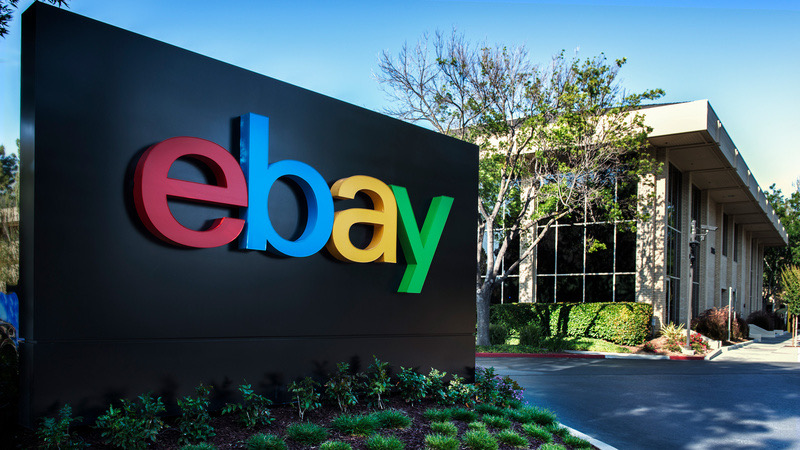Did You Know
eBay's Expanding Realm: 25 Million Sellers and 157 Million Buyers and Counting

In the vast realm of e-commerce, eBay stands as a beacon of success, bringing together a staggering 25 million sellers and an impressive 157 million registered buyers. With these numbers growing by the second, eBay has become a bustling marketplace where global trade thrives. In this blog post, we dive into the significance of eBay's ever-increasing community, exploring the factors contributing to its continued success.
Unveiling the Powerhouse: eBay's Ever-Growing Community of 25 Million Sellers and 157 Million Buyers
In the vast landscape of e-commerce, eBay stands tall as a powerhouse, revolutionizing the way people buy and sell goods online. With a staggering 25 million sellers and an impressive 157 million registered buyers, the platform has become a thriving marketplace where the world connects to trade and explore unique products. What makes eBay truly remarkable is its ever-increasing numbers, which continue to soar every second. In this blog post, we delve into the significance of eBay's vast and ever-growing community, exploring the factors contributing to its sustained success.
The Phenomenon of eBay's Sellers
With 25 million sellers actively participating on the platform, eBay has created an entrepreneurial haven where individuals and businesses alike can thrive. The seller community on eBay is diverse, ranging from individual hobbyists selling handmade crafts to established businesses offering a wide array of products. This diversity of sellers enriches the platform, ensuring that buyers can find virtually anything they desire, from rare collectibles to everyday essentials.
The eBay platform empowers sellers by providing them with easy-to-use listing tools, a vast global audience, and various resources to optimize their sales. For many, eBay has been a launchpad to establish successful e-commerce enterprises, enabling them to reach a massive customer base while minimizing the overhead costs associated with traditional retail.
The Pinnacle of Online Buyer Experience
On the flip side, eBay's 157 million registered buyers form an extensive and engaged customer base that fuels the platform's growth. The sheer number of buyers on eBay provides sellers with unparalleled opportunities to showcase their products to a vast audience. From the buyer's perspective, this means access to an extensive range of products, whether they are hunting for vintage items, hunting gear, or the latest tech gadgets.
eBay's reputation as a trusted and reliable platform has been integral to its popularity among buyers. With secure payment options and robust buyer protection policies, shoppers can confidently make purchases from a wide range of sellers worldwide. Additionally, eBay's user-friendly interface, search filters, and personalized recommendations enhance the shopping experience, making it convenient and enjoyable.
Continuous Growth: The Driving Force
The constant increase in the number of sellers and buyers on eBay is a testament to the platform's adaptability and commitment to innovation. eBay has consistently adapted to changing market trends and customer preferences, ensuring its relevance in an ever-evolving digital landscape.
Several factors contribute to the sustained growth of eBay's community:
- Global Reach: eBay operates in numerous countries, creating a truly global marketplace. This cross-border accessibility allows sellers to reach customers beyond their local markets, and buyers can access unique products from different corners of the world.
- Mobile-Friendly Approach: eBay's seamless mobile application enables buyers and sellers to engage with the platform anytime, anywhere, making it extremely convenient for users.
- Community and Trust: eBay fosters a sense of community among its users through seller ratings, buyer reviews, and support forums. This builds trust and confidence among buyers and sellers, driving repeat business and word-of-mouth referrals.
- Diverse Product Selection: eBay's vast and diverse inventory ensures that buyers find products they need, while sellers can tap into niche markets and cater to specific interests.
eBay's impressive numbers of 25 million sellers and 157 million registered buyers paint a picture of a thriving online marketplace that has redefined the way commerce operates in the digital age. The platform's ability to accommodate millions of sellers, each offering unique products, has been the key to its success. Simultaneously, its vast and engaged buyer community has contributed to the growth and vibrancy of the eBay ecosystem.
As the world embraces digital solutions, eBay continues to be at the forefront, adapting to changing times and consistently improving the user experience. With every passing second, the eBay family grows larger, marking the unwavering trust and confidence of millions worldwide in this e-commerce giant. Whether you're a buyer or a seller, eBay remains a fascinating platform to explore and participate in the dynamic world of online trade.
Barbie: The Evolution of Barbara Millicent Roberts - From Modest Origins to Iconic Toy
Unveiling the History and Evolution of Barbie: From Barbara Millicent Roberts to Iconic Toy
Step into the captivating world of Barbie, the beloved fashion doll that has charmed generations of children and adults alike. This blog delves into the fascinating history and evolution of Barbie, originally known as Barbara Millicent Roberts, and her remarkable journey from a simple teenage fashion model to a global cultural icon. Discover the reasons behind her creation and the lasting impact she continues to have on popular culture and beyond.
When you hear the name "Barbie," an image of a stylish, glamorous doll with an impeccable fashion sense likely springs to mind. However, beneath the surface of this iconic toy lies a rich history and a journey of evolution that began with a modest origin. The original name of this world-famous toy is Barbara Millicent Roberts, and her story reveals intriguing insights into the reasons behind her creation and her enduring impact on popular culture.
The original name of the world-famous toy Barbie is Barbara Millicent Roberts. Created by Ruth Handler, co-founder of Mattel Inc., in 1959, Barbie was inspired by Ruth's observation of her daughter's imaginative play with paper dolls. Ruth envisioned a three-dimensional doll that could serve as an aspirational figure, representing diverse careers and lifestyles for young girls to emulate. Thus, Barbara Millicent Roberts, commonly known as Barbie, was introduced to the world, sporting a black-and-white striped swimsuit and a ponytail hairstyle. Over the years, Barbie has evolved, embracing diversity and reflecting changing cultural norms, but her legacy as a beloved fashion doll and empowering role model remains intact.
The evolution of Barbara Millicent Roberts into simply "Barbie" is a testament to the power of branding and cultural influence. As Barbie gained popularity worldwide, her full name gradually transitioned into the more accessible and memorable "Barbie." The name change not only simplified the doll's identity but also allowed her to transcend linguistic and cultural barriers, making her easily recognizable across the globe. Today, "Barbie" is not just a toy; she has become a household name and an iconic figure, symbolizing imagination, aspiration, and fashion for generations of children and collectors alike. The journey from Barbara Millicent Roberts to Barbie showcases the impact a well-crafted brand can have on shaping the collective imagination and leaving an indelible mark on popular culture.
The Birth of Barbie - A Historical Perspective: In 1959, the iconic Barbie doll was born and introduced to the world by Ruth Handler, the co-founder of Mattel Inc., a renowned American toy company. The inspiration for Barbie came from Ruth's observation of her daughter, Barbara, who often enjoyed playing with paper dolls and engaging in imaginative role-playing activities. This observation sparked the idea of creating a three-dimensional, adult-looking doll that could be dressed in a range of fashionable outfits.
The Evolution of Barbie: Barbie's journey began as a teenage fashion model, known by her full name, Barbara Millicent Roberts. Her first appearance showcased her donning a black-and-white striped swimsuit and a ponytail hairstyle. Since then, Barbie has undergone various transformations to keep up with changing times and cultural trends.
Throughout the years, Barbie's appearance has evolved to represent diverse ethnicities, body types, and professions, aiming to become more inclusive and reflective of the diverse world she inhabits. These efforts to embrace diversity and promote positive role models have been well-received by parents, educators, and society at large.
Present Status of Barbie: As of today, Barbie remains an iconic and best-selling toy worldwide. Her popularity extends beyond her traditional role as a doll, inspiring movies, merchandise, books, and even video games. Additionally, Barbie continues to collaborate with renowned designers, creating limited-edition fashion collections that attract both children and adult collectors alike.
Barbie's positive impact also extends beyond entertainment, as Mattel has leveraged her influence to support various social initiatives. From promoting education for girls to raising awareness about environmental sustainability, Barbie has become an advocate for empowering and educating children around the globe.
Reasons for Creating Barbie: The creation of Barbie was driven by several factors that have contributed to her enduring success:
1. Imaginative Play: Barbie was designed to encourage imaginative play among children, helping them explore different roles and careers while fostering creativity.
2. Aspirational Figure: By embodying various professions, Barbie has served as an aspirational figure for young girls, showing them that they can be anything they desire, from doctors and astronauts to entrepreneurs and artists.
3. Fashion and Style: Barbie's ever-evolving wardrobe and passion for fashion have allowed her to remain relevant in the ever-changing world of trends and styles.
4. Empowerment and Self-Expression: Through Barbie, girls have been able to express themselves and shape their identity by choosing dolls that resonate with their interests and personalities.
From her humble beginnings as Barbara Millicent Roberts to becoming a global cultural icon, Barbie's journey has been nothing short of remarkable. Her enduring popularity is a testament to the impact she has had on generations of children, encouraging creativity, diversity, and empowerment. Barbie's ability to adapt to the changing times while retaining her core values and purpose has secured her place in the hearts of millions, making her more than just a doll but a symbol of limitless possibilities for all.
As Barbie continues to inspire and empower future generations, her legacy as an iconic toy remains unwavering, and her influence on popular culture will undoubtedly continue for many more years to come.
From Bagels to Bliss: The Sweet Journey of Ben & Jerry's Ice Cream

Sanjay K Mohindroo
Discover the extraordinary tale of Ben & Jerry's, the iconic ice cream brand that captivated the world with its delectable flavors and heartwarming mission. Uncover how two friends, originally aspiring to start a bagels company, stumbled upon the sweet magic of ice cream, transforming their lives and the dessert industry forever.
In the world of delectable desserts, few names evoke as much delight as Ben & Jerry's. Known for their creatively named ice cream flavors and philanthropic initiatives, Ben Cohen and Jerry Greenfield's brainchild has become a global sensation. However, not many know that this iconic ice cream empire had much humbler beginnings as a bagel company. Join us as we explore the fascinating journey of Ben & Jerry's from bagels to blissful ice creams!
The Early Dream of Bagels
In the early 1970s, two childhood friends, Ben Cohen, and Jerry Greenfield, decided to venture into the food business together. They attended a correspondence course on ice cream making at Penn State University but soon realized that the cost of an ice cream parlor was too steep for their budget. Instead, they set their sights on opening a bagel shop in their hometown of Burlington, Vermont.
However, fate had different plans for this duo, as a series of unexpected events led them to pivot towards a new venture that would change the course of their lives and redefine the ice cream industry.
The Ice Cream Serendipity
As destiny would have it, the pair's plans for a bagel shop hit a roadblock when they discovered that obtaining a suitable location and equipment proved more challenging than expected. Frustrated but undeterred, they stumbled upon a used ice cream-making machine advertised for sale. Intrigued by the idea of making ice cream, they decided to give it a shot, even though they had no prior experience in the field.
Embracing the Philosophy of Inclusion
One of the defining aspects of Ben & Jerry's ice cream is its dedication to embracing inclusion and social responsibility. As they experimented with their ice cream recipes, Cohen and Greenfield ensured that the flavors they developed were not only delicious but also catered to a diverse range of tastes. This ethos of inclusivity was rooted in their belief that everyone should have the opportunity to enjoy their tasty creations.
The Breakthrough Flavor: "Chunky Monkey"
In 1984, Ben & Jerry's struck gold with the creation of their now-famous flavor, "Chunky Monkey." Comprising a delightful blend of banana ice cream, fudge chunks, and walnuts, this flavor rapidly gained popularity and remains a beloved classic to this day. The success of "Chunky Monkey" marked a turning point for the company, propelling them towards nationwide recognition and establishing their brand as a force to be reckoned with in the ice cream industry.
Social and Environmental Activism
Apart from its mouthwatering ice creams, Ben & Jerry's is equally renowned for its strong commitment to social and environmental causes. From supporting fair trade practices to advocating for climate justice, the company has consistently used its platform to promote positive change in the world. They were among the first companies to offer employees paid time off to participate in community service, showcasing their dedication to giving back to the community.
The journey of Ben & Jerry's from a bagel shop to a globally renowned ice cream brand is a testament to the power of passion, resilience, and serendipity. Ben Cohen and Jerry Greenfield's delightful and innovative ice cream flavors, coupled with their unwavering commitment to social responsibility, have made Ben & Jerry's a beloved household name.
Next time you indulge in a scoop of Ben & Jerry's ice cream, remember the story of how two friends turned an unexpected twist of fate into a sweet success story that continues to bring joy to millions around the world. As the company stays true to its founding principles, one can't help but admire the delicious revolution sparked by a dream of bagels.
The Amazing Variety of Coca-Cola Products: A Comprehensive Guide

Coca-Cola is one of the most recognizable brands in the world, but did you know that it has around 3500 beverages and 500 products under its catalog? This blog post will explore the amazing variety of Coca-Cola products and how they cater to different tastes, preferences, and occasions. Whether you are looking for a refreshing soda, hydrating water, a nutritious juice, a stimulating coffee, a soothing tea, or something else, you will find it in the Coca-Cola family. Let's dive in!
Coca-Cola is one of the world's most recognizable and successful brands, with a history spanning more than a century. But did you know Coca-Cola has much more to offer than its iconic soft drink? Coca-Cola has around 3500 beverages and 500 products under its catalog, catering to different tastes, preferences, and needs of consumers across the globe.
From sparkling drinks to still beverages, from juices to teas, from sports drinks to water, Coca-Cola has a diverse portfolio of products that can quench your thirst, refresh your mood, energize your body, or simply satisfy your curiosity. Some of these products are well-known, such as Sprite, Fanta, Minute Maid, Powerade, and Dasani. Others are more regional or niche, such as Thums Up in India, Inca Kola in Peru, Barq's in the US, or Ayataka in Japan.
Coca-Cola constantly innovates and expands its product range, responding to changing consumer demands and market trends. For example, Coca-Cola recently launched Topo Chico Hard Seltzer, a low-calorie alcoholic beverage made with sparkling water and natural flavors. Coca-Cola also acquired Costa Coffee, a leading UK, and European coffee chain, to enter the hot beverage segment. Coca-Cola also offers products that are tailored to specific dietary or health needs, such as Coca-Cola Zero Sugar, Coca-Cola with Coffee, Honest Tea, and Simply Orange.
With such a rich and varied product catalog, Coca-Cola aims to provide something for everyone, no matter where they are or what they are looking for. Coca-Cola believes that every product it makes should deliver quality, value, and enjoyment to its consumers. That's why Coca-Cola is more than just a drink. It's a lifestyle.
But how does Coca-Cola innovate its products? Coca-Cola follows a consumer-centric approach, listening to what people want and need, and creating products that meet or exceed their expectations. Coca-Cola also monitors market trends and opportunities and adapts its products accordingly. For example, Coca-Cola recently launched Topo Chico Hard Seltzer, a low-calorie alcoholic beverage made with sparkling water and natural flavors, to tap into the growing popularity of hard seltzers. Coca-Cola also acquired Costa Coffee, a leading UK, and European coffee chain, to enter the hot beverage segment.
Coca-Cola also offers products that are tailored to specific dietary or health needs, such as Coca-Cola Zero Sugar, Coca-Cola with Coffee, Honest Tea, and Simply Orange. Some of these products are well-known, such as Sprite, Fanta, Minute Maid, Powerade, and Dasani. Others are more regional or niche, such as Thums Up in India, Inca Kola in Peru, Barq's in the US, or Ayataka in Japan.
With such a rich and varied product catalog, Coca-Cola aims to provide something for everyone, no matter where they are or what they are looking for. Coca-Cola believes that every product it makes should deliver quality, value, and enjoyment to its consumers. That's why Coca-Cola is not just a drink. It's an innovation.
Embracing the "Green Thing": Lessons from a Simpler Time

Discover the profound wisdom of an older generation as they reflect on a time when environmental consciousness wasn't a trend but a way of life. In this blog post, we explore the sustainable practices of the past and how they can inspire us to embrace a greener future.
In a nostalgic encounter at a store, a cashier enlightens an older woman about the harmful impact of plastic bags on the environment. Apologetically, the woman shares that in her day, they simply didn't have the "green thing." As we reflect on her words, we discover the profound sustainability practices of the past and the importance of embracing them in our present lives. Let's take a journey back in time to explore the simple yet eco-conscious habits that characterized an era without the "green thing."
Recycling and Reusing: During this bygone era, recycling was a way of life. Returning milk bottles, Coke bottles, and beer bottles to the store allowed for their thorough cleaning, sterilization, and reuse. Unlike today's disposable culture, these bottles were recycled countless times, minimizing waste and conserving resources. While they may not have called it the "green thing" back then, their actions were inherently sustainable.
Conservation through Daily Choices: Walking was the norm in those days, as escalators weren't present in every store or office building. People didn't rely on 300-horsepower machines to cover short distances; instead, they traversed the streets on foot. Similarly, the absence of energy-intensive appliances compelled them to wash diapers, dry clothes on lines, and blend ingredients manually. These practices conserved energy and reduced their carbon footprint.
Resourcefulness and Mindful Consumption: In the absence of today's consumer-driven culture, hand-me-down clothing was commonplace. Families shared clothes between siblings, appreciating the value of reuse and the avoidance of unnecessary waste. The size of televisions and radios was modest, and they served as communal entertainment devices, not cluttering every room. Packaging fragile items involved repurposing newspapers as cushioning material, fostering a culture of resourcefulness.
Prioritizing Human Power: Lawn maintenance meant using a push mower, powered by human effort, rather than relying on gasoline-guzzling engines. Physical work integrated exercise into daily routines, making gym memberships and electric treadmills obsolete. By embracing human power, they unknowingly embraced sustainable practices, keeping their environment cleaner and their bodies healthier.
Thoughtful Consumption Habits: In the absence of disposable cups and plastic bottles, people quenched their thirst by drinking from fountains. Pens were refilled with ink, and razor blades were replaced, extending the life of everyday items. These small choices symbolized a commitment to minimalism, frugality, and reducing waste—an embodiment of the "green thing" before its time.
Efficient Transportation and Resource Management: Back then, streetcars were the preferred mode of transportation, and children rode bikes or school buses to reach their destinations. Homes had only one electrical outlet in each room, discouraging excessive energy consumption. People didn't rely on computerized gadgets to navigate the world; they embraced simplicity and relied on their local knowledge.
As we reflect on the older woman's sentiment that they didn't have the "green thing," we realize that her generation unknowingly pioneered sustainable practices that we can learn from today. Their commitment to recycling, reusing, conserving energy, and embracing resourcefulness was a way of life. By revisiting and integrating their values into our modern lives, we can become better stewards of the environment and create a more sustainable future. Let us be inspired by their actions and make the "green thing" our thing.
The Original Name of Amazon: From Cadabara to Success
Discover the fascinating journey of the e-commerce giant Amazon and how it transitioned from its original name, Cadabara, to the globally recognized brand it is today. Explore the reasons behind the name change and its impact on the company's success.
When we hear the name "Amazon" today, the first thing that comes to mind is the global e-commerce giant founded by Jeff Bezos. Amazon has become synonymous with online shopping, cloud computing, and innovation. However, it may surprise many that the company's original name was not Amazon. It started its journey under a different moniker - Cadabara. This name, although creative and unique, encountered pronunciation issues that led to its eventual transformation into the globally recognized brand we know today.
In the mid-1990s, when Jeff Bezos first conceived the idea of an online bookstore, he needed a name that would reflect the vastness and diversity of products he envisioned selling. After much contemplation, Bezos settled on the name "Cadabara." The name Cadabara was derived from the magical word "abracadabra," often associated with wonder, amazement, and enchantment. It seemed fitting for an enterprise that aimed to captivate customers and offer a wide array of products at their fingertips.
However, as Bezos and his team began to introduce Cadabara to potential investors, friends, and family, they quickly discovered an unexpected obstacle - pronunciation issues. Many people struggled to say the name correctly, often mishearing it as "Cadabra" or "Cadabara." This confusion was a significant concern for Bezos, as he realized that a name that was difficult to pronounce could hinder the company's potential for growth and success. It became clear that a change was necessary.
Realizing the need for a name that was easier to pronounce and remember, Bezos initiated a rebranding process. He wanted a name that would evoke the same sense of wonder and amazement as Cadabara but would be more accessible and globally recognizable. After extensive research and brainstorming, Bezos and his team settled on the name "Amazon."
The name Amazon had several appealing qualities. Firstly, it referenced the Amazon River, the largest river in the world by volume, symbolizing the vastness and scale of Bezos' ambitions for the company. Additionally, the name Amazon evoked images of exoticism and adventure, reflecting the diverse range of products Amazon aimed to offer. Moreover, Amazon had a certain ring to it, with a simple and memorable pronunciation that could easily be recognized in various languages and cultures. These attributes made it the perfect choice to represent the company's identity and goals.
With the new name in place, Amazon began its journey toward becoming the global e-commerce powerhouse we know today. Under the leadership of Jeff Bezos, the company expanded its offerings beyond books, diversified into various industries, and revolutionized the way people shop. The name change from Cadabara to Amazon marked a turning point in the company's history, allowing it to transcend linguistic barriers and establish a strong brand identity worldwide.
In retrospect, it is intriguing to consider what might have happened if Amazon had persisted with the name Cadabara. Would it have achieved the same level of success and recognition? It is difficult to say for certain, but it is undeniable that the decision to change the name was pivotal. By addressing the pronunciation issues and rebranding as Amazon, the company overcame linguistic barriers, fostered global recognition, and ultimately thrived in the competitive world of e-commerce.
The story of Amazon's original name, Cadabara, and its subsequent transformation into the iconic brand we know as Amazon is a testament to the importance of effective branding and the power of a name. While Cadabara may have possessed its sense of magic and wonder, the pronunciation issues it encountered necessitated a change. With the adoption of the name Amazon, the company found a name that resonated with people worldwide, propelling it toward unparalleled success and solidifying its place as one of the most influential companies of our time.
Unveiling the CIA's Digital Arsenal: Analyzing 5 Million Tweets Daily

Explore the far-reaching capabilities of the Central Intelligence Agency (CIA) as it delves into the realm of social media. Discover how the CIA harnesses the power of Twitter, analyzing a staggering five million tweets every day to gather insights and detect potential threats. This article examines the implications of the CIA's digital arsenal, including concerns surrounding privacy and security.
In today's digitally interconnected world, social media platforms have become hubs of information sharing and communication. Recognizing the power of these platforms, intelligence agencies around the globe have increasingly turned their attention to online spaces in their pursuit of valuable insights. One such agency is the Central Intelligence Agency (CIA) of the United States, which reportedly analyzes a staggering five million tweets every day. This article delves into the implications of this practice, exploring the CIA's digital arsenal and the concerns it raises regarding privacy and security.
Harnessing the Power of Social Media
The CIA's fascination with social media is driven by its potential as a vast, real-time source of intelligence. With billions of users and an incessant flow of information, platforms like Twitter provide a unique window into public sentiment, emerging trends, and even covert activities. By monitoring tweets, the CIA aims to identify patterns, detect potential threats, and gain a deeper understanding of global events.
Analyzing Five Million Tweets
Analyzing five million tweets daily is no small feat. To accomplish this, the CIA relies on sophisticated algorithms and powerful data analysis tools. These technologies sift through the vast amount of data, filtering out noise and focusing on relevant information. The agency leverages natural language processing, sentiment analysis, and network mapping techniques to extract valuable insights from social media chatter.
Detecting Threats and Gathering Intelligence
The primary objective of the CIA's tweet analysis is to detect potential threats to national security. By monitoring public conversations, the agency can identify emerging trends, sentiments, and discussions related to security risks. This information can aid in preemptive measures against terrorism, cyber-attacks, and other forms of potential harm.
Furthermore, the CIA's analysis extends beyond threat detection. The agency is interested in gathering intelligence on various global issues, such as political developments, public opinion on policies, and even potential recruitment activities by extremist organizations. The wealth of information available on social media platforms allows the agency to paint a more comprehensive picture of the world.
Privacy and Ethical Concerns
The CIA's massive data analysis operation naturally raises concerns about privacy and ethics. While the agency insists that it focuses solely on public information, the line between public and private can become blurry in the digital realm. Social media users often share personal details, opinions, and sensitive information without fully comprehending the potential consequences.
Critics argue that the CIA's practice of analyzing tweets infringes upon individuals' right to privacy. The sheer volume of data collected raises questions about the extent of personal information that could be gleaned from seemingly innocuous posts. Additionally, the potential for misuse or abuse of such data by government agencies remains a significant concern.
Balancing Security and Privacy
The challenge lies in striking a balance between national security and individual privacy. Intelligence agencies argue that the rapid evolution of digital communication necessitates proactive measures to safeguard citizens from threats. However, it is crucial to establish clear guidelines and oversight mechanisms to ensure that the privacy of individuals is respected and that data collection and analysis are conducted within legal and ethical boundaries.
The CIA's practice of analyzing five million tweets daily reflects the growing importance of social media platforms as valuable sources of information for intelligence agencies. While it offers the potential for enhanced threat detection and deeper insights into global issues, concerns regarding privacy and ethical boundaries cannot be overlooked. Striking the right balance between security and individual privacy remains a complex challenge that requires ongoing dialogue and careful consideration to preserve both national security and civil liberties in the digital age.